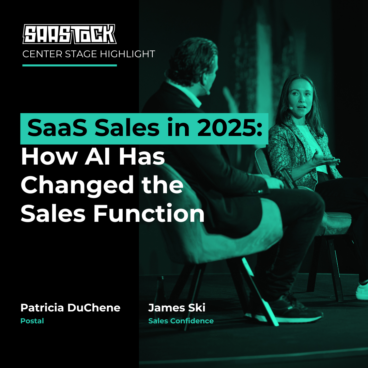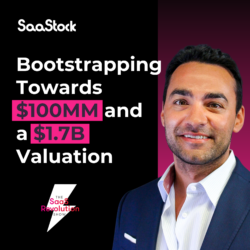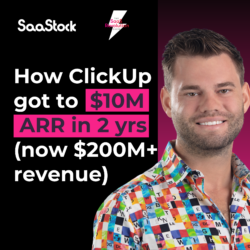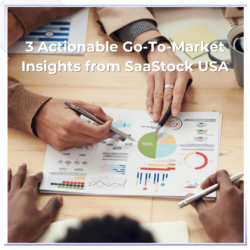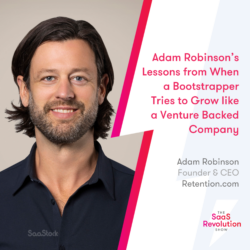AI has disrupted the traditional SaaS sales motion. Pre 2023 (and certainly pre-Covid), the standard SaaS sales motion flowed from Sales Development Reps (sourcing and landing meetings) to Account Executives (working through to close) to post-sales (ensuring customer success and retention). But with AI-powered technology making the sales funnel more efficient, the roles and requirements of your sales team have shifted.
For example, offline engagement platform Postal, which has achieved 5,000%+ revenue growth in the past three years, only employs one SDR to filter leads and three full-time AEs to handle everything else with technology taking on much of the funnel work.
“Everybody in your go-to-market team can take on more responsibility,” says Patricia DuChene, CRO at Postal. “Because of technology we have become inherently more efficient with our time and the monkey work doesn’t need to be done by us anymore.”
At SaaStock Europe, DuChene discussed how AI has changed the sales function and what good looks like in 2025. Watch the full interview below or read on for our top five takeaways.
1. Take the time to implement AI RevOps successfully
When implemented successfully, AI RevOps technology can do 80-90% of certain sales funnel work, such as messaging (i.e. tone improvements for reps), post-sales (i.e. tier one support) and top-of-the-funnel sourcing. But with so much technology available, carefully choose the right tech stack for your needs and then take your time to implement the tools successfully.
For example, Postal found it both complex and time-consuming to plug in Clay (AI outreach agent), 6Sense (AI pipeline builder) and Cognism (B2B contact data) to its corporate Open AI account and then set up the right parameters. But the perseverance was worth it.
“We’ve really tried to remove a lot of the hunting and we’re trying to be way more purposeful in the time we spend when we’re deciding to contact someone. We now have a ‘Why You,’ a ‘Why Now’ and we know with a certain amount of certainty that someone should be interested in our product.”
2. Leverage AI SDRs, human SDRs and full cycle AEs
Be it the ‘cold-calling SDR’, the ‘closer AE’ or the ‘success-focused support team’, each member of the sales organisation used to have specialised roles. Now, the roles and responsibilities of what makes a great SDR and AE have fundamentally changed.
For instance, Postal has one human SDR whose role is now entirely inbound, acting as the filtration system for all of the inbound leads generated by AI technology (the ‘AI SDR’) and only sending the most qualified opportunities to the AEs. The AEs then take over the rest of the customer journey.
“There is a world for many companies where junior full funnel AEs could be all you need. Through segmentation, you can create a graduation path for AEs so they learn progressively over time, initially working smaller deals with smaller accounts to master their communication and business acumen, then moving up into larger segments.”
3. Choose the right sales personas for your stage
If you’re trying to identify your ICP and establish product-market fit, you don’t need a sales leader. Instead, choose a missionary over a mercenary, and look for a swiss army knife salesperson with around two years closing experience who is eager to jumpstart their career.
“You need a missionary when you’re first getting started. Mercenaries are hired guns that come later, but that doesn’t work when you’re trying to figure out product-market fit.”
On the other hand, if you’re ready to hire your first sales leader, look for a go-to-market partner, who will shepherd you, try things out and be hands on.
“There are so many failures that are going to happen that you need someone who wants to figure it out with you and is committed to staying when things suck.”
4. Adopt PLG to survive without a sales team (at the start)
Product-led growth (PLG) is a proven GTM strategy, but it doesn’t fit every business model, product type or customer segment. For PLG to work, you need to:
- Have a really strong foothold in either the SMB space or in siloed teams within larger organisations.
- Be at a price point where siloed teams can purchase your technology on a corporate credit card autonomously.
- Focus on smaller or mid-market prospects.
If you fit that criteria, you can survive for a long time without a sales team, but when you start selling to larger enterprise accounts, you’ll need a sales team to interact with multiple people, build human relationships and get multi-million dollar deals over the line.
“As soon as you want more market share, you have to hire sales reps because there’s a certain price point and certain size of customer that just isn’t going to buy on their own.”
5. Don’t forget customer retention
Great customer success and retention often takes a backseat to customer acquisition, but spending so much money to acquire a customer only to let them walk away after 1-2 years is a mistake. Instead, commit budget to post-sales and take advantage of upcoming developments in post-sales AI capability, such as the ability to identify when and why a customer needs CSM attention and automatically triggering the exact messaging required.
“It’s so much easier to squeeze a little bit more revenue from a customer than it is from someone who’s brand new. So when you’re getting into revenue planning for Q1 2025, remember to provision some budget for that side of the business.”
